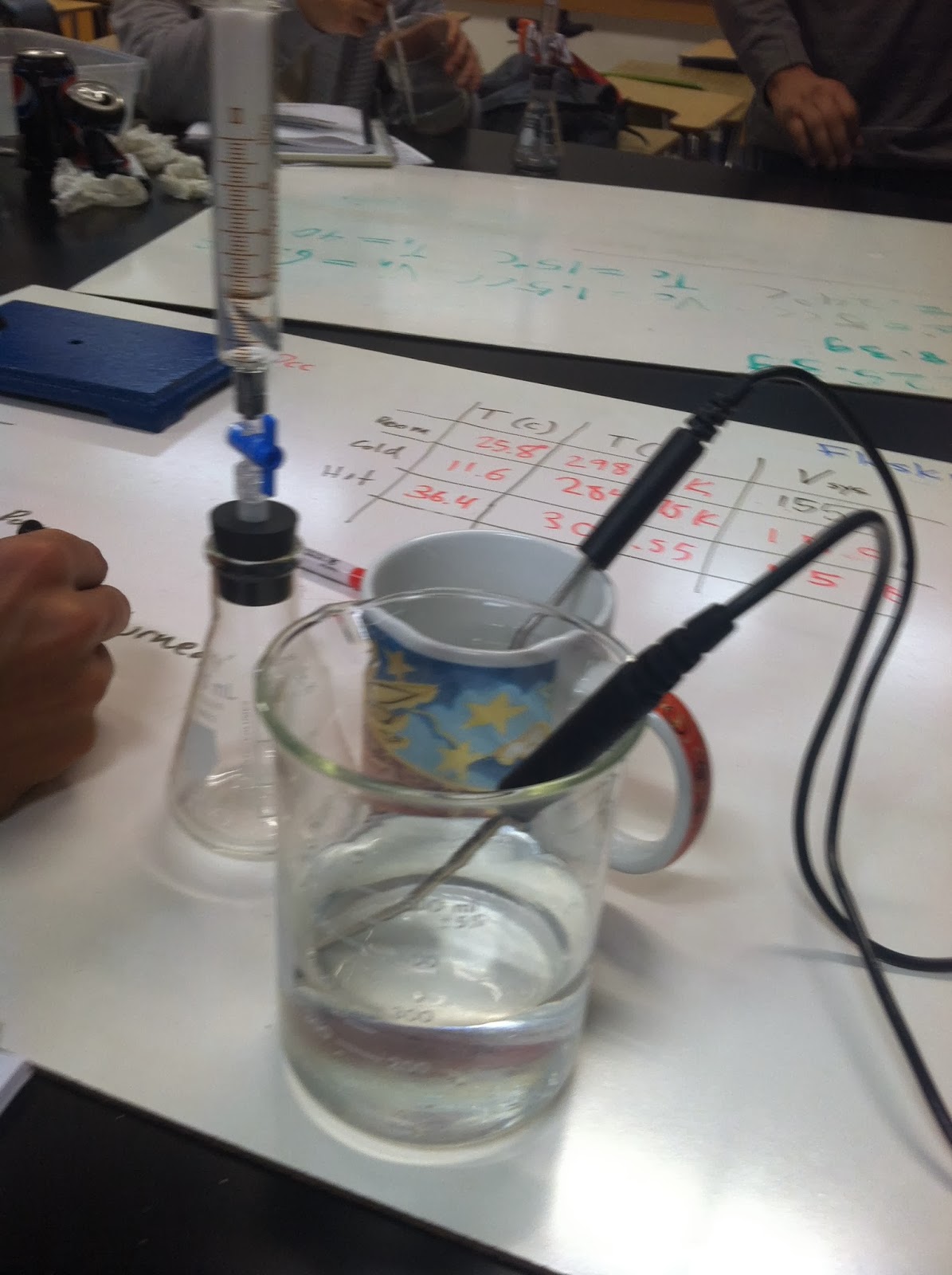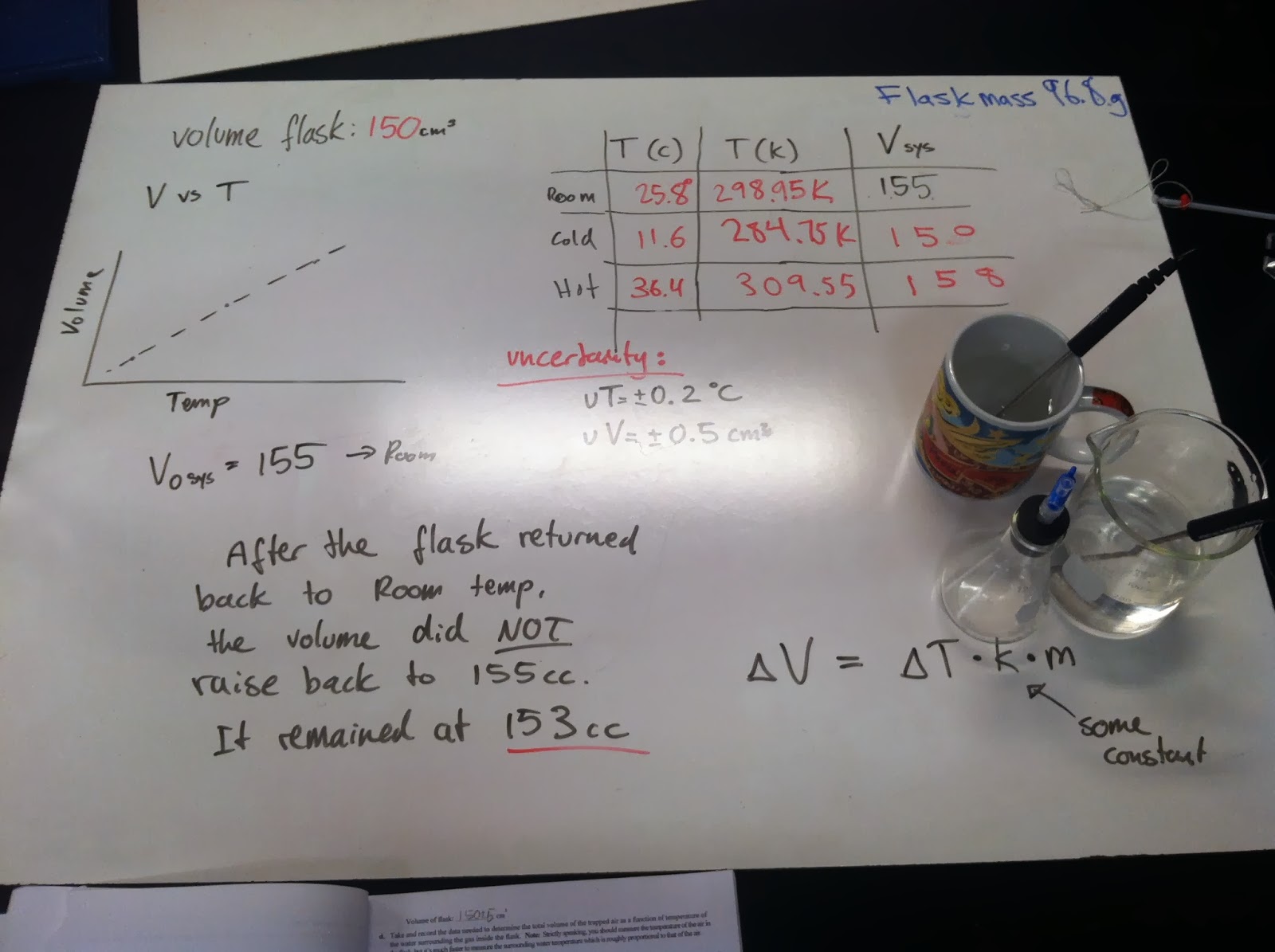Wednesday, March 26, 2014
Flux and Fields
We used this apparatus to determine how angle decreasing would effect the overall flux in an electric field ( the number of nails)
We used Loggerpro to determine the graphical behavior of the flux
We observed a sinusoidal behavior where the flux or nail decreased
We determined that the flux was dependent on the net charge enclosed in the Gaussian surface
Throughout this lab we wanted to observe and calculate the behaviors of flux in certain situations
Monday, March 24, 2014
The Electric Field
We used ActivPhysics to answer the above questions that pertained to the behavior of particles of like charge, opposite charge, or differing magnitudes. We varying the distances, number of particles, and charges to observe their behavior with each other
We were given an extended charge distribution. We were given an insulated object with uniformly distributed charge and were excepted to compute the corresponding electric field experienced by a given point at a given distance d. We utilized excel to do most of the calculations to give an approximate value as to what the point p would be experiencing if it was a charged particle.
We were given the assignment to use an interactive program to demonstrate the behaviors a charged particle or in the case of the game the "puck" would experience as a result of the attributes that another charged particles would exert on it due to its electrical field.
Throughout this lab we discussed and conducted experiments to demonstrate the behavior particles go through when in the presence of another particle , where they would experience a force and therefore an electric field. We observed the superposition principle where multiple charges were in the same given area of each other.
Wednesday, March 19, 2014
Electric Static Force
 |
| We observed the tape would repel when both pieces of tape had the same charge and attract when they had been oppositely charged. |
Monday, March 17, 2014
Heat Engines, Refridgeration, and Entropy
We were given a diesel cycle PV graph, which we were to use to determine pressure, volume, and temperature at given points as well as the heat, work, internal energy, and entropy at sections between points. As a result, we should be able to calculate the efficiency of the engine given the information provided and necessary equations.
At different point's and steps we used the various equations that were needed for adiabatic compression, constant pressure, and constant volume. Furthermore, we used our understanding of the relationships under certain conditions to eliminate either Q, W, or delta U.
We were supposed to get a total internal energy of zero based on the theory of a cycle, which states that between the work and heat transfer the overall system should be zero at the end. I ended up getting 50 J over which I failed to find the mistake.
At different point's and steps we used the various equations that were needed for adiabatic compression, constant pressure, and constant volume. Furthermore, we used our understanding of the relationships under certain conditions to eliminate either Q, W, or delta U.
We were supposed to get a total internal energy of zero based on the theory of a cycle, which states that between the work and heat transfer the overall system should be zero at the end. I ended up getting 50 J over which I failed to find the mistake.
Wednesday, March 12, 2014
Heat Engines and Thermodynamics
The P-V cycle is used here to find the different states and how to use those states to find the energy. We used the first law of thermodynamics to eliminate either W depending on the conditions of constant velocity. We also used the idea of delta E= nRT3/2 to find the change of energy between to points.
The Carnot engine cycle is what we used here it alternated between states of adiabatic and isobaric. We used these ideas to understand that at certain points the heat transfer Q is zero, also under constant pressure delta V is proportional to the temperature. If Q was zero between points we used delta E = W for the change in volume was it did work.
Here we had a isochoric situation where the temperature increase was proportional to the deltaE increase, since work was zero
Here we had a situation of isobaric where the work increased with a volume change and the higher heat change increased created a somewhat linear increase in delta E.
Here we solved for the specific heat under conditions of constant pressure
Monday, March 10, 2014
State Variables and Ideal Gas laws
The Fire Syringe we used to find the final temperature in an insulated system where we quickly heated the system to create minimal heat transfer from cylinder striking the material out of the tube.
Here on the bottom we did work on the system in insulated conditions, compressing the volume of air inside the cylinder and raising the internal heat causing a combustion.
We use the dimensions of the cylinder to calculate volume using the relationship pi r^2 L ,where we had an L initial and L final, and a given radius, we used room temperature at 24 degrees Celsius then converted to kelvins
Here on the bottom we did work on the system in insulated conditions, compressing the volume of air inside the cylinder and raising the internal heat causing a combustion.
We use the dimensions of the cylinder to calculate volume using the relationship pi r^2 L ,where we had an L initial and L final, and a given radius, we used room temperature at 24 degrees Celsius then converted to kelvins
Wednesday, March 5, 2014
Charles law I
We utilized these devices to try and identify a relationship between temperature change and volume change.
We observed in our experiment with pressure being constant, as the temperature increased, so did the volume, likewise as the temperature decreased, so did the volume, thus giving evidence of a proportionality between the two measurements. V/T=nR/P with right side being constant
We graphed our data to confirm what we believed to be a proportionality between Temperature and volume at constant pressure. The slope V/T had units cm^3/ K and constant of 1/3, which displayed what we observed I our data table.
We did the experiments to observe the relationships and behaviors of various variables T,V, P under certain conditions. Observing the experiments, solving the equations, and plotting the graphs served to fully understand the important aspects of the gas laws specially ideal.
Monday, March 3, 2014
Lab 2 Thermal Expansion
Linear Thermal Expansion -Lab 1

We utilized a metal rod, rotary motion sensor, and steam produced by the
immersion heater to cause linear expansion. The rotary sensor captured the angular displacement and the temperature sensors captured the heat.
The graph represents the temp vs time and the bottom graph is the angular displacement in response to the steam passing through rod and causing the material to expand.
We used the linear expansion formula to solve for the unknown alpha constant, which is based on the thermal expansion properties of a particular material, in this case it was close to the aluminum coefficient of linear expansion within an uncertainty of α=2.93x10-5 ± 3.904x10-6 C-1 .
Since we had uncertainty with the rotary motion detector we propagated the linear expansion equation and found 3.904x10^-6 and our final answer fell within the uncertainty range as I stated above
Latent Heat -Lab 2
Here is our calculations for latent heat of vaporization, which is the energy per mass to cause a liquid to change to gas 2409140 J/kg
Here we used a statistical method to use the different lab groups numbers to create an uncertainty among our measured values that resembles an average of the calculated and our experimental value fell with in it
+/- 836164.998 J/kg
Ideal Gas Law -Lab 3
We used this apparatus to measure the pressure over the area in the syringe
the first graph showed the proportionality relationship between pressure and temperature and the bottom showed the two temperatures collected
here we wrote about the relation ship pV=nrt in the above graph and also from the one you displayed the proportionality of pressure vs temperature.
here was the calculations on the graph that confirmed the inverse relationship between pressure and volume as volume increase pressure decreases.
Throughout all three labs we utilized different devices and analytical tools to confirmed relationships among behaviors dealing with temperature change and gas, solid, and liquids. We initially focused on solids and heat and their interconnectedness, next we looked at solid to liquids specifically the latent heat of fusion that calculated the energy to phase change, and finally the relationship among pressure, volume and temperature specially the inverse relationship among volume and pressure , and the proportionality of pressure and temperature .

We utilized a metal rod, rotary motion sensor, and steam produced by the
immersion heater to cause linear expansion. The rotary sensor captured the angular displacement and the temperature sensors captured the heat.
We used the linear expansion formula to solve for the unknown alpha constant, which is based on the thermal expansion properties of a particular material, in this case it was close to the aluminum coefficient of linear expansion within an uncertainty of α=2.93x10-5 ± 3.904x10-6 C-1 .
Since we had uncertainty with the rotary motion detector we propagated the linear expansion equation and found 3.904x10^-6 and our final answer fell within the uncertainty range as I stated above
Latent Heat -Lab 2
Again we used an immersion heater of 297.6 W and temperature sensors, but in this experiment we tried to determine the amount of energy to melt a kilogram of ice per degree Celsius referred to as latent heat of vaporization.
This graph shows how the temperature vs time of the ice melting in response to the constant energy input from the immersion heater. It flattened out until having enough energy per mass to reach the latent heat of fusion where it would transition to liquid, but we captured the latent heat of vaporization in our graphs and calculations. Which is consistent based on the different energy required to phase change.
Here we used a statistical method to use the different lab groups numbers to create an uncertainty among our measured values that resembles an average of the calculated and our experimental value fell with in it
+/- 836164.998 J/kg
Ideal Gas Law -Lab 3
We used this apparatus to measure the pressure over the area in the syringe
the first graph showed the proportionality relationship between pressure and temperature and the bottom showed the two temperatures collected
here we wrote about the relation ship pV=nrt in the above graph and also from the one you displayed the proportionality of pressure vs temperature.
here was the calculations on the graph that confirmed the inverse relationship between pressure and volume as volume increase pressure decreases.
Throughout all three labs we utilized different devices and analytical tools to confirmed relationships among behaviors dealing with temperature change and gas, solid, and liquids. We initially focused on solids and heat and their interconnectedness, next we looked at solid to liquids specifically the latent heat of fusion that calculated the energy to phase change, and finally the relationship among pressure, volume and temperature specially the inverse relationship among volume and pressure , and the proportionality of pressure and temperature .
Subscribe to:
Comments (Atom)






































